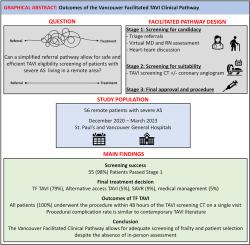An Optimized Assessment Pathway for Remote Patients: The Vancouver Facilitated Transcatheter Aortic Valve Implantation Program
IF 2.5
Q2 CARDIAC & CARDIOVASCULAR SYSTEMS
引用次数: 0
Abstract
Background
Novel pathways are needed to accommodate the increasing demand for transcatheter aortic valve implantation (TAVI) and ensure equitable access. A single Vancouver Facilitated TAVI program (VFTP) based at St. Paul's and Vancouver General Hospitals was established to streamline the assessment of remote patients with severe aortic stenosis using virtual technologies.
Methods
Remote patients with severe aortic stenosis who expressed difficulties traveling to complete their pre-TAVI workup were included and received prospective follow-up. Clinical and echocardiographic parameters were reported per the Valve Academic Research Consortium 3.
Results
Between December 2020 and March 2023, a total of 56 remote patients were included in the VFTP. The mean patient age was 79.7 ± 9.1 years. A total of 55 patients (98%) passed the screening for candidacy; 45 patients (80%) were found suitable for transfemoral TAVI, 5 patients (9%) were directed toward surgical aortic valve replacement; 3 (5%) underwent alternative-access TAVI; and 2 patients (4%) were assigned to a watchful waiting strategy. No inpatient mortality, stroke, or major bleeding occurred in the transfemoral TAVI group, and the median hospital stay was 1 day (interquartile range, 1-2 days; range, 1-24 days). Two patients had an access-closure failure requiring surgical intervention; 1 patient had tamponade; and 4 patients had complete heart block requiring permanent pacemaker implantation. No hospital readmission had occurred at 30 days.
Conclusions
A simplified assessment pathway to assess TAVI candidacy using virtual technologies is safe and feasible. The VFTP potentially can increase access to TAVI and reduce inequity in TAVI care.

远程患者的优化评估途径:辅助 TAVI 计划
背景为满足日益增长的经导管主动脉瓣植入术(TAVI)需求并确保公平就诊,需要新的途径。温哥华协助 TAVI 计划(VFTP)设在圣保罗医院和温哥华总医院,旨在利用虚拟技术简化对偏远地区严重主动脉瓣狭窄患者的评估。方法纳入表示难以前往完成 TAVI 术前检查的偏远地区严重主动脉瓣狭窄患者,并对其进行前瞻性随访。结果2020年12月至2023年3月期间,共有56名远程患者被纳入VFTP。患者平均年龄为 79.7 ± 9.1 岁。共有 55 名患者(98%)通过了候选资格筛选;45 名患者(80%)适合经股动脉 TAVI,5 名患者(9%)接受了外科主动脉瓣置换术,3 名患者(5%)接受了替代入路 TAVI,2 名患者(4%)被指定为观察等待策略。经股动脉 TAVI 组未发生住院死亡、中风或大出血,住院时间中位数为 1 天(四分位间范围为 1-2 天;范围为 1-24 天)。有两名患者出现入路关闭不全,需要手术治疗;一名患者出现血栓形成;四名患者出现完全性心脏传导阻滞,需要植入永久起搏器。结论 使用虚拟技术评估 TAVI 候选资格的简化评估路径是安全可行的。VFTP 有可能提高 TAVI 的可及性,减少 TAVI 治疗中的不公平现象。
本文章由计算机程序翻译,如有差异,请以英文原文为准。
求助全文
约1分钟内获得全文
求助全文
来源期刊

CJC Open
Medicine-Cardiology and Cardiovascular Medicine
CiteScore
3.30
自引率
0.00%
发文量
143
审稿时长
60 days
 求助内容:
求助内容: 应助结果提醒方式:
应助结果提醒方式:


